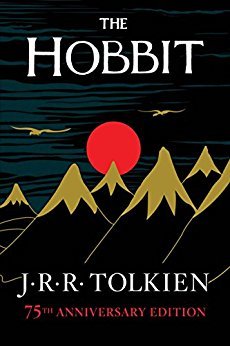The Hobbit (The Lord of the Rings, #0)
Title: The Hobbit (The Lord of the Rings, #0)

Author: J.R.R. Tolkien
Published in: 1937
Date read: 22nd December 2015
Score: 5/5
Genre: Fantasy, Classic
Plot: (Warning, may contain spoilers):
"The Hobbit," published in 1937, is J.R.R. Tolkien's classic fantasy novel, serving as a prelude to "The Lord of the Rings." It's a whimsical yet epic tale of adventure, courage, and self-discovery, introducing readers to the rich mythology of Middle-earth.
The story begins in the cosy, comfortable hobbit-hole of Bilbo Baggins, a respectable and rather unadventurous hobbit of the Shire. His peaceful life is abruptly disrupted when the wizard Gandalf the Grey and a company of thirteen dwarves, led by Thorin Oakenshield, arrive on his doorstep.
Gandalf, without much explanation, enlists Bilbo as the "burglar" for a perilous quest. The dwarves' goal is to reclaim their ancestral home and vast treasure in the Lonely Mountain (Erebor), which was long ago stolen and now guarded by Smaug, a terrifying and immensely powerful dragon. Bilbo, much to his own dismay and initial protest, is swept along on this grand adventure.
Their journey is fraught with danger and encounters with various creatures and challenges. They face:
• The brutish trolls who try to cook them.
• The dark, labyrinthine caves of the Goblins, where Bilbo famously encounters Gollum and acquires the magical One Ring (though its true significance is not yet known).
• The perilous forests of Mirkwood, home to giant spiders and suspicious Wood-elves.
• The hospitable house of Beorn, the shapeshifting skin-changer.
Through these trials, Bilbo, initially timid and homesick, slowly begins to discover an inner resilience, cunning, and bravery he never knew he possessed. He uses his wit, the Ring's invisibility, and his growing courage to save himself and his companions multiple times.
Upon reaching the Lonely Mountain, the dwarves manage to re-enter their ancient kingdom, but Smaug remains a formidable obstacle. Bilbo, using his "burglar" skills, confronts the dragon, discovering a crucial weakness. This leads to Smaug's eventual confrontation with the people of Lake-town, and his dramatic downfall.
Smaug's defeat, however, precipitates a new crisis: the Battle of Five Armies. Elves, Men, and Dwarves gather to claim the dragon's vast treasure, leading to conflict. Bilbo, having seen enough of greed and violence, attempts to broker peace, but ultimately, all sides must unite against an unexpected, greater threat of invading Goblins and Wargs.
The novel concludes with Bilbo returning to the Shire, a changed hobbit, richer in experience and wisdom, though much less "respectable" in the eyes of his neighbours. "The Hobbit" is a timeless tale that seamlessly blends thrilling adventure with deeper themes of heroism, greed, and the quiet courage of unlikely heroes.
Comments:
Yet another book that every child should read and I was over 30 when I finally read it, a tragedy. I have ensured that my children read it when they were children. A wonderful story all through showing an unbelievable imagination from the author. I have enjoyed the film versions but can't see how Peter Jackson managed to stretch this book out to three long films, but he did and it worked well.
Books that we've read by J.R.R. Tolkien (4):
The Hobbit (The Lord of the Rings, #0) (1937), The Fellowship of the Ring (Middle Earth, #1) (1954), The Two Towers (Middle Earth, #3) (1954), The Return of the King (Middle Earth, #4) (1955)
This page was updated on: 10th August 2025

